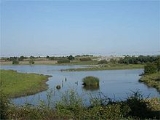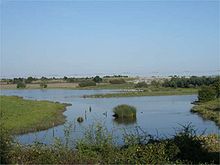
Sandbach Flashes
Encyclopedia

Wetland
A wetland is an area of land whose soil is saturated with water either permanently or seasonally. Wetlands are categorised by their characteristic vegetation, which is adapted to these unique soil conditions....
west of Sandbach
Sandbach
Sandbach is a market town and civil parish in the unitary authority of Cheshire East and the ceremonial county of Cheshire, England. The civil parish contains four settlements; Sandbach itself, Elworth, Ettiley Heath and Wheelock....
in Cheshire
Cheshire
Cheshire is a ceremonial county in North West England. Cheshire's county town is the city of Chester, although its largest town is Warrington. Other major towns include Widnes, Congleton, Crewe, Ellesmere Port, Runcorn, Macclesfield, Winsford, Northwich, and Wilmslow...
, England
England
England is a country that is part of the United Kingdom. It shares land borders with Scotland to the north and Wales to the west; the Irish Sea is to the north west, the Celtic Sea to the south west, with the North Sea to the east and the English Channel to the south separating it from continental...
. The flashes were designated as a Site of Special Scientific Interest
Site of Special Scientific Interest
A Site of Special Scientific Interest is a conservation designation denoting a protected area in the United Kingdom. SSSIs are the basic building block of site-based nature conservation legislation and most other legal nature/geological conservation designations in Great Britain are based upon...
in 1963, with a total area of 1.53 km². There are a number of individual flashes including Fodens Flash and Elton Flashes.
Part of the site is managed by the Sandbach Flashes Joint Management Committee.
Description of site
Sandbach Flashes consists of a series of poolsPond
A pond is a body of standing water, either natural or man-made, that is usually smaller than a lake. A wide variety of man-made bodies of water are classified as ponds, including water gardens, water features and koi ponds; all designed for aesthetic ornamentation as landscape or architectural...
formed as a result of subsidence
Subsidence
Subsidence is the motion of a surface as it shifts downward relative to a datum such as sea-level. The opposite of subsidence is uplift, which results in an increase in elevation...
due to the solution
Solution
In chemistry, a solution is a homogeneous mixture composed of only one phase. In such a mixture, a solute is dissolved in another substance, known as a solvent. The solvent does the dissolving.- Types of solutions :...
of underlying salt deposits. The water varies from freshwater
Freshwater
Fresh water is naturally occurring water on the Earth's surface in ice sheets, ice caps, glaciers, bogs, ponds, lakes, rivers and streams, and underground as groundwater in aquifers and underground streams. Fresh water is generally characterized by having low concentrations of dissolved salts and...
, chemically similar to other Cheshire meres
Mere (lake)
Mere in English refers to a lake that is broad in relation to its depth, e.g. Martin Mere. A significant effect of its shallow depth is that for all or most of the time, it has no thermocline.- Etymology :...
, to highly saline
Saline water
Saline water is a general term for water that contains a significant concentration of dissolved salts . The concentration is usually expressed in parts per million of salt....
. Most of the flashes are surrounded by semi-improved or improved grassland. Fodens Flash is partly surrounded by wet woodland
Woodland
Ecologically, a woodland is a low-density forest forming open habitats with plenty of sunlight and limited shade. Woodlands may support an understory of shrubs and herbaceous plants including grasses. Woodland may form a transition to shrubland under drier conditions or during early stages of...
.
Biodiversity
Inland saline habitats such as those present at Sandbach Flashes are extremely rare in Britain and support unusual communities of plants and animals.Due to the differing age, depth, and water chemistry, the flashes show considerable variation in their plant and animal communities. The most recently formed have narrow disjunct stands of emergent vegetation
Emergent plant
An emergent plant is one which grows in water but which pierces the surface so that it is partially in air. Collectively, such plants are emergent vegetation....
dominated by Great Reedmace
Typha
Typha is a genus of about eleven species of monocotyledonous flowering plants in the family Typhaceae. The genus has a largely Northern Hemisphere distribution, but is essentially cosmopolitan, being found in a variety of wetland habitats...
Typha latifolia and occasionally by Lesser Pond-sedge
Carex
Carex is a genus of plants in the family Cyperaceae, commonly known as sedges. Other members of the Cyperaceae family are also called sedges, however those of genus Carex may be called "true" sedges, and it is the most species-rich genus in the family. The study of Carex is known as...
Carex acutiformis, whilst the oldest have extensive stands of Common Reed Phragmites australis. At Fodens Flash the emergent vegetation grades into fen
Fen
A fen is a type of wetland fed by mineral-rich surface water or groundwater. Fens are characterised by their water chemistry, which is neutral or alkaline, with relatively high dissolved mineral levels but few other plant nutrients...
and wet woodland
Wet woodland
Wet woodland is a biodiversity habitat in the United Kingdom.This is a woodland that occurs on poorly drained or seasonally wet soils. They are typical of river valley, the surroundings of mires and raised bog, the transition zones between open water and drier ground, and beside small winding...
dominated by Alder
Alder
Alder is the common name of a genus of flowering plants belonging to the birch family . The genus comprises about 30 species of monoecious trees and shrubs, few reaching large size, distributed throughout the North Temperate Zone and in the Americas along the Andes southwards to...
Alnus glutinosa and willow
Willow
Willows, sallows, and osiers form the genus Salix, around 400 species of deciduous trees and shrubs, found primarily on moist soils in cold and temperate regions of the Northern Hemisphere...
Salix spp. Wood small-reed Calamagrostis epigejos is locally dominant in the ground flora here.
In some areas periodic flooding occurs and species such as Water-pepper
Water-pepper
Water-pepper or Water pepper is a plant of the family Polygonaceae. It grows in damp places and shallow water. It is a cosmopolitan plant, found in Australia, New Zealand, temperate Asia, Europe, and North America...
Polygonum hydropiper, Plicate Sweet-grass Glyceria plicata and Celery-leaved Water-crowfoot Ranunculus sceleratus occur. Shore-weed Littorella uniflora, a rare plant in Cheshire, is also present.
The more saline flashes are fed by natural brine springs
Spring (hydrosphere)
A spring—also known as a rising or resurgence—is a component of the hydrosphere. Specifically, it is any natural situation where water flows to the surface of the earth from underground...
and contain a range of species tolerant of brackish water, for example, Spiked Water-milfoil Myriophyllum spicatum, Fennel-leaved Pondweed
Potamogeton
Potamogeton is a genus of aquatic, mostly freshwater, plants of the family Potamogetonaceae. Most are known by the common name pondweed, although many unrelated plants may be called pondweed, such as Canadian pondweed...
Potamogeton pectinatus and Horned Pondweed Zannichellia palustris and the green alga Enteromorpha intestinalis.
Adjacent to these saline flashes are areas of saltmarsh vegetation containing species such as Sea Aster Aster tripolium, Lesser Sea-spurrey Spergularia marina and Reflexed Saltmarsh-grass Puccinellia distans.
A number of uncommon aquatic invertebrates occur including the mayfly
Mayfly
Mayflies are insects which belong to the Order Ephemeroptera . They have been placed into an ancient group of insects termed the Palaeoptera, which also contains dragonflies and damselflies...
Caenis robusta and the snail
Snail
Snail is a common name applied to most of the members of the molluscan class Gastropoda that have coiled shells in the adult stage. When the word is used in its most general sense, it includes sea snails, land snails and freshwater snails. The word snail without any qualifier is however more often...
Gyraulis laevis, and species associated with brackish water habitats including the water boatmen Sigara concinna and S. stagnalis and the shrimps Gammarus duebeni and G. tigrinus.
The flashes support significant numbers of wildfowl and wader
Wader
Waders, called shorebirds in North America , are members of the order Charadriiformes, excluding the more marine web-footed seabird groups. The latter are the skuas , gulls , terns , skimmers , and auks...
s as migrant
Bird migration
Bird migration is the regular seasonal journey undertaken by many species of birds. Bird movements include those made in response to changes in food availability, habitat or weather. Sometimes, journeys are not termed "true migration" because they are irregular or in only one direction...
s and winter visitors. The principal species are Wigeon
Wigeon
The Eurasian Wigeon, also known as Widgeon or Eurasian Widgeon is one of three species of wigeon in the dabbling duck genus Anas. It is common and widespread within its range...
, Teal
Common Teal
The Eurasian Teal or Common Teal is a common and widespread duck which breeds in temperate Eurasia and migrates south in winter. The Eurasian Teal is often called simply the Teal due to being the only one of these small dabbling ducks in much of its range...
, Lapwing
Northern Lapwing
The Northern Lapwing , also known as the Peewit, Green Plover or just Lapwing, is a bird in the plover family. It is common through temperate Eurasia....
and Snipe
Common Snipe
The Common Snipe is a small, stocky wader native to the Old World. The breeding habitat is marshes, bogs, tundra and wet meadows throughout northern Europe and northern Asia...
.
The woodland at Fodens Flash has a rich lichen
Lichen
Lichens are composite organisms consisting of a symbiotic organism composed of a fungus with a photosynthetic partner , usually either a green alga or cyanobacterium...
flora.

